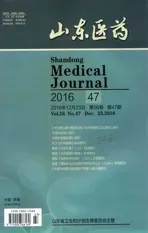转染miR-214抑制物的口腔鳞癌细胞SCC15增殖、迁移、侵袭能力变化及其机制
2016-02-07许驰强肖金刚
许驰强,肖金刚
(西南医科大学附属口腔医院,四川泸州646000)
转染miR-214抑制物的口腔鳞癌细胞SCC15增殖、迁移、侵袭能力变化及其机制
许驰强,肖金刚
(西南医科大学附属口腔医院,四川泸州646000)
目的 观察转染miR-214抑制剂的口腔鳞癌SCC15细胞增殖、迁移、侵袭能力的变化,并探讨其机制。方法 取体外培养的口腔鳞癌SCC15细胞,分为观察组、阴性对照组和空白对照组,观察组和阴性对照组分别用Lipofectamine2000转染miR-214 抑制物、无关序列,空白对照组不转染。采用实时荧光定量PCR法检测转染24 h时各组细胞中miR-214的表达,用CCK-8法观察转染24、48、72 h各组细胞增殖情况,用划痕实验观察转染24 h时各组细胞迁移能力,用Transwell实验观察转染24 h时各组侵袭能力,用Western blotting法检测转染24 h时各组细胞中的Wnt通路拮抗因子Dickkopf 相关蛋白-3(DKK-3)及Wnt通路关键基因β-catenin蛋白。结果 转染24 h时,与阴性对照组和空白对照组相比,观察组细胞miR-214相对表达量低,划痕愈合百分比低,穿膜细胞数少,β-catenin蛋白相对表达量低,DKK-3蛋白相对表达量高(P均<0.05)。转染48、72 h观察组OD值低于阴性对照组和空白对照组(P均<0.05)。结论 转染miR-214抑制物的口腔鳞癌SCC15细胞增殖、迁移及侵袭能力下降。其机制可能是因为转染miR-214抑制物能抑制Wnt/β-catenin信号通路相关蛋白DKK-3、β-catenin蛋白表达。
微小RNA;miR-214;口腔鳞状细胞癌;细胞增殖;细胞迁移;细胞侵袭;Wnt信号通路;Dickkopf 相关蛋白-3;β-catenin蛋白
口腔癌是头颈部较常见的恶性肿瘤之一,以鳞状细胞癌最为常见,约占全身恶性肿瘤的3%[1],虽然近年来医疗水平不断提高,新型药物不断开发应用,但口腔癌患者总生存率却没有得到明显的提高[2、3],肿瘤侵袭及转移是口腔癌患者死亡的重要原因。微小RNA(miRNAs)是一种单链非编码RNA,与恶性肿瘤关系密切[4]。miR-214在口腔鳞癌中表达增高[5]。近期有研究报道miR-214通过Wnt信号通路影响食管癌[6]和肺癌[7]细胞的增殖、侵袭、转移,但miR-214在口腔鳞癌增殖、侵袭、转移过程中发挥的作用及机制尚不明确。本研究观察了转染miR-214 抑制物的口腔鳞癌SCC15细胞增殖、迁移、侵袭能力及Wnt通路拮抗因子Dickkopf相关蛋白-3(DKK-3)和Wnt通路关键蛋白β-catenin蛋白的表达变化,旨在明确转染miR-214抑制物的口腔鳞癌SCC15细胞增殖、侵袭、转移能力的变化及其可能机制。
1 材料与方法
1.1 材料 miR-214抑制物及阴性对照无关序列均购自广州锐博生物科技公司,TRIzol试剂和脂质体2000(Lipofectamine2000)购自美国Invitrogen公司,实时荧光定量PCR相关试剂购自北京Promega公司,引物由上海生工公司设计合成,Transwell购自美国Corning公司,基质胶购自美国BD公司,CCK-8试剂盒购自上海东仁化学科技公司,β-catenin、DKK-3单克隆抗体和HRP标记羊抗鼠二抗购自美国Abcam公司。人口腔鳞状细胞癌细胞系SCC15购自中国科学院典型培养物保藏细胞库,人正常口腔黏膜角化细胞系HOK购自美国Sciencell公司。
1.2 细胞分组及转染方法 口腔鳞癌SCC15细胞用含10%胎牛血清的RPMI1640培养基在37 ℃、5%CO2培养箱中常规传代,取对数生长期细胞进行实验。设观察组、阴性对照组和空白对照组。观察组和阴性对照组分别转染转染miR-214抑制物、无关序列,操作按Lipofectamine2000试剂盒说明书进行。空白对照组不转染。
1.3 各组miR-214检测 转染24 h时采用实时荧光定量PCR法检测各组miR-214相对表达量,TRIzol法提取细胞总RNA, 测RNA浓度,按逆转录试剂盒说明书逆转录合成cDNA。以2 μL cDNA配置PCR体系,PCR反应条件: 94 ℃ 2 min,94 ℃ 20 s,60 ℃ 30s,40个循环。以U6作为内参基因。每次实验至少重复3次,miR-214表达量采用2-ΔΔCt法计算。
1.4 各组细胞增殖情况观察 采用CCK-8法。 取转染24、48、72 h各组细胞,将细胞接种于96孔板,向每孔加入10 μL CCK-8溶液,培养箱孵育2 h,用酶标仪测定450 nm处的光密度(OD)值。每组细胞设6个复孔,实验重复3次。
1.5 各组细胞迁移能力观察 采用细胞划痕实验。取转染24 h各组细胞,将细胞接种于6孔板中,细胞生长完全融合后,用10 μL枪头在孔板中心轴处沿直线轻轻划痕,PBS冲洗去除漂浮细胞后继续培养,培养24 h后在显微镜下观察拍照,以细胞划痕愈合百分比表示细胞迁移能力,细胞愈合百分比=(实验前划痕宽度-培养24 h后划痕宽度)/实验前划痕宽度×100%。
1.6 各组细胞侵袭能力观察 采用Transwell实验。用Matrigel基质胶包被Transwell小室基底膜。收集转染24 h各组细胞,重悬于无血清培液中饥饿培养16 h,向上室加入含1×105个细胞的细胞悬液,下层加入含10%FBS的培养基,37 ℃和5%CO2下孵箱培养24 h后取出,擦净上层小室内未迁移的细胞,4%多聚甲醛固定,0.5%结晶紫染色,随机选取显微镜下选5个视野,计数穿膜细胞数,取平均值。
1.7 各组SCC15细胞中DKK-3、β-catenin检测 采用Western blotting法。收集转染24 h各组细胞,加入配置预冷的RIPA裂解液,充分匀浆裂解提取总蛋白,BCA法测定蛋白样品浓度。每组取30 μg蛋白上样,SDS-聚丙烯酰胺凝胶上电泳30 min,5%脱脂牛奶室温封闭1 h,加入适当浓度一抗,4 ℃过夜,次日洗膜后,加入HRP标记的二抗,室温孵育1 h,洗膜后,将膜置于ECL中,于凝胶成像系统中曝光并采集图像。结果以目的基因条带灰度值与GAPDH条带灰度值的比值表示。

2 结果
2.1 各组细胞转染24 h miR-214相对表达量比较 观察组、阴性对照组、空白对照组miR-214相对表达量分别为0.41±0.07、1.03±0.02、1.04±0.05。观察组细胞miR-214相对表达量低于阴性对照组和空白对照组(P均<0.05);阴性对照组和空白对照组miR-214相对表达量差异无统计学意义。
2.2 各组转染24、48、72 h细胞增殖情况比较 各组转染24、48、72 h时OD值见表1。转染48、72 h观察组OD值低于阴性对照组和空白对照组(P均<0.05);阴性对照组和空白对照组OD值差异无统计学意义。转染24 h各组OD值差异无统计学意义。

表1 不同时点各组OD值比较
2.3 各组转染24 h细胞迁移能力比较 观察组、阴性对照组、空白对照组划痕愈合百分比分别为41.5%±3.1%、80.1%±5.0%、83.1%±6.1%。观察组划痕愈合百分比低于阴性对照组和空白对照组(P均<0.05),阴性对照组和空白对照组划痕愈合百分比差异无统计学意义。
2.4 各组转染 24 h细胞侵袭能力比较 观察组、阴性对照组、空白对照组穿膜细胞数分别为(54±10)、(185±24)、(191±26)个/HP。观察组穿膜细胞数少于阴性对照组和空白对照组(P均<0.05),阴性对照组和空白对照组穿膜细胞数差异无统计学意义。
2.5 各组转染24 h细胞中DKK-3、β-catenin 蛋白表达比较 观察组、阴性对照组、空白对照组DKK-3蛋白相对表达量分别为0.61±0.11、0.12±0.03、0.11±0.04,β-catenin 蛋白相对表达量分别为0.54±0.12、0.95±0.14、0.93±0.16。观察组DKK-3蛋白相对表达量高于阴性对照组和空白对照组(P均<0.05),β-catenin蛋白相对表达量低于阴性对照组和空白对照组(P均<0.05);阴性对照组和空白对照组DKK-3、β-catenin 蛋白相对表达量差异无统计学意义。
3 讨论
miR-214位于人1号染色体长臂(1q24.3)非编码基因Dnm3os内[8],参与机体的细胞发育、细胞衰老及血管形成等生理过程[9、10]。近年研究发现miR-214在在多种恶性肿瘤中表达异常,与肿瘤发生发展关系密切[6]。Zhang等[11]发现miR-214在鼻咽癌组织和细胞中高表达,抑制鼻咽癌细胞miR-214的表达能够促进癌细胞的凋亡并抑制其增殖。Penna等[12]报道miR-214在恶性黑色素瘤中表达增高,并且通过对抑癌基因TFAP2C的抑制促进肿瘤的进展。Zhang等[13]发现胰腺癌中miR-214的表达较癌旁组织明显增高,上调胰腺癌细胞miR-214的表达能够降低癌细胞对吉西他滨的敏感性,并且可能与miR-214对Wnt通路相关基因Wnt3A的调控有关。目前研究证实在多数恶性肿瘤中miR-214高表达,但Derfoul等[14]发现,乳腺癌组织中miR-214的表达较癌旁组织显著下降。Wang等[15]发现miR-214在胃癌组织和胃癌细胞中表达下调,miR-214通过靶向CSF1影响癌增殖、侵袭和转移。以上结果说明miR-214在不同的恶性肿瘤中存在异质性,可能与miR-214在不同恶性肿瘤中通过不同的靶基因参与恶性肿瘤的进展有关。Scapoli等[16]发现口腔鳞癌组织miR-214表达显著增高,但未进行机制方面的研究。肿瘤的侵袭及转移是肿瘤患者死亡的主要原因之一,研究证实miR-214通过不同的机制影响癌细胞的增殖、侵袭及转移[6,7,11~15]等生物学行为。本研究结果显示,观察组口腔鳞癌SCC15细胞转染miR-214 抑制物后,miR-214表达下调,细胞增殖、迁移、侵袭能力下降,说明miR-214在口腔鳞癌的进展中起着促癌基因的作用。
Wnt信号通路是多细胞真核生物中高度保守的信号通路[17],调控细胞的增殖、凋亡、分化等生理过程,Wnt/β-catenin通路是经典Wnt通路,也是目前研究最多、最深入的Wnt通路,Wnt/β-catenin通路主要通过激活β-catenin在核内的功能来调节靶基因,Wnt信号通路的异常激活是以细胞内β-catenin的积聚为特征,激活许多下游靶基因[18]参与多种恶性肿瘤的发生发展[19~22]。DKK-3是Wnt信号通路拮抗因子DDK家族成员之一,能够阻止LRP-5、LRP-6与Wnt、Fz配体或受体复合物的结合,从而影响β-catenin在细胞质内的积聚,抑制经典Wnt信号通路[23,24]。已有研究表明miR-214在食管癌[6]、肺癌[7]、胰腺癌[13]等肿瘤中发挥的作用均与Wnt通路有关。本研究发现观察组转染miR-214抑制物下调SCC15细胞miR-214表达后,细胞内DDK-3表达上升,β-catenin的表达下降,说明miR-214对口腔鳞癌细胞增殖、迁移及侵袭行为的影响与Wnt/β-catenin通路的调控有关,miR-214可能通过对DDK-3及β-catenin表达的调控影响口腔鳞癌细胞的生物学行为,miR-214调控Wnt/β-catenin通路具体的机制尚需在后面的实验中进一步研究证实。
[1] 郑家伟,李金忠,张志愿,等.口腔鳞状细胞癌临床流行病学研究现状[J].中国口腔颌面外科杂志,2007,5(2):83-90.
[2] Cannon TL,Lai DW,Hirsch D,et al.Squamous cell carcinoma of the oral cavity in nonsmoking women:a new and unusual complication of chemotherapy for recurrent ovariancancer[J]. Oncologist, 2012,17(12):1541-1546.
[3] Dibble EH,Alvarez AC,Truong MT,et al.18F-FDG metabolic tumor volume and totalglycolytie activity of oral cavity and oropharyngeal squamous cell cancer:adding value to clinical staging[J].J Nucl Med, 2012,53(5):709-715.
[4] Penna E, Orso F, Taverna D. miR-214 as a key hub that controls cancer networks: small player, multiple functions [J]. J Clin Investig Dermatol, 2015,135(4):960-969.
[5] Scapoli L,Palmieri A,Lo Muzio L,et al. MicroRNA expression profiling of oral carcinoma identifies new markers of tumor progression[J]. Int J Immunopathol Pharmacol, 2010,23(4):1229-1234.
[6] Xu Y,Lu S. Regulation of β-catenin-mediated esophageal cancer growth and invasion by miR-214[J] . Am J Transl Res, 2015,7(11):2316-2325.
[7] Qi W,Chen J,Cheng X,et al. Targeting the Wnt-regulatory protein CTNNBIP1 by microRNA-214 enhances the stemness and self-renewal of cancer stem-like cells in lung adenocarcinomas [J]. Stem Cells, 2015,33(12):3423-3436.
[8] Bar-Eli M. Searching for the 'melano-miRs': miR-214 drives melanoma metastasis[J]. EMBO J, 2011, 30(10):1880-1881.
[9] Chen H,Shalom-Feuerstein R,Riley J,et al. miR-7 and miR-214 are specifically expressed during neuroblastoma differentiation,cortical development and embryonic stem cells differentiation,and control neurite outgrowth in vitro[J]. Biochem Biophys Res Commun, 2010,394(4):921-927.
[10] Van Balkom BW,De Jong OG,Smits M,et al. Endothelial cells require miR-214 to secrete exosomes that suppress senescence and induce angiogenesis in human and mouse endothelial cells[J]. Blood, 2013,121(19):3997-4006.
[11] Zhang Z,Li Y,Wang H,et al. Knockdown of miR-214 promotes apoptosis and inhibits cell proliferation in nasopharyngeal carcinoma[J]. PLoS One, 2014,9(1):86149.
[12] Penna E,Orso F,Cimino D,et al. microRNA-214 contributes to melanoma tumour progression through suppression of TFAP2C[J]. EMBO J, 2011,30(10):1990-2007.
[13] Zhang XJ, Ye H, Zeng CW,et al. Dysregulation of miR-15a and miR-214 in human pancreatic cancer [J]. J Hematol Oncol, 2010,3(22):46.
[14] Derfoul A, Juan AH, Difilippantonio MJ, et al. Decreased microRNA -214 levels in breast cancer cells coincides with increased cell proliferation, invasion and accumulation of the Polycomb Ezh2 methyltransferase [J]. Carcinogen, 2011,32 (11):1607-1614.
[15] Wang Y, Shi D, Chen X,et al. Clinicopathological significance of microRNA-214 in gastric cancer and its effect on cell biological behaviour[J]. PLoS One, 2014,9(3):91307.
[16] Scapoli L,Palmieri A,Lo-Muzio L,et al. MicroRNA expression profiling of oral carcinoma identifies new markers of tumor progression[J]. Int J Immunopathol Pharmacol, 2010,23(4):1229-1234.
[17] Tian W,Han X,Yan M,et al.Structure-based discovery of a novel inhibitor targeting theβ-catenin/Tcf 4 interaction[J].Biochemistry,2012,51(2):724-731.
[18] Giles RH,van Es JH,Clevers H. Caught up in a Wnt storm: Wnt signaling in cancer[J]. Biochim Biophys Acta,2003,1653(1):1-24.
[19] Monin MB,Krause P,Stelling R,et al. The anthelmintic niclosamide inhibits colorectal cancer cell lines via modulation of the canonical and noncanonical Wnt signaling pathway[J]. J Surg Res, 2016,203(1):193-205.
[20] He J,Zhou M,Chen X,et al. Inhibition of SALL4 reduces tumorigenicity involving epithelial-mesenchymal transition via Wnt/β-catenin pathway in esophageal squamous cell carcinoma[J]. J Exp Clin Cancer Res, 2016,35(1):98.
[21] Ahmed RA,Alawin OA,Sylvester PW. γ-Tocotrienol reversal of epithelial-to-mesenchymal transition in human breast cancer cells is associated with inhibition of canonical Wnt signalling[J]. Cell Prolif, 2016,49(4):460-470.
[22] 杨莉,杨志宏. Wnt信号通路成分Wnt-5a和β-连接蛋白在卵巢癌组织中的表达及意义[J]. 山东医药,2015,55(36):61-63..
[23] Pannone G,Bufo P,Santoro A,et al.WNT pathway in oral cancer: epigenetic inactivation of WNT-inhibitors[J].Oncol Rep,2010,24(4):1035-1041.
[24] Yue W, Sun Q, Dacic S, et al. Downregulation of Dkk3 activates beta-catenin/TCF-4 signaling in lung cancer[J].Carcinogenesis,2008,29(1):84-92.
Changes in proliferation, migration and invasion abilities of oral squamous-cell carcinoma SCC15 cells transfected by miR-214 inhibitor and its mechanism
XUChiqiang,XIAOJingang
(TheAffiliatedOralHospitalofSouthwestMedicalUniversity,Luzhou646000,China)
Objective To investigate the changes in proliferation, migration and invasion abilities of oral squamous-cell carcinoma SCC15 cells transfected by miR-214 inhibitor, and to explore the mechanism. Methods The oral squamous-cell carcinoma SCC15 cells cultured in vitro were randomly divided into the observation group, negative control group and blank control group. SCC15 cells in the observation group and negative control group were transfected with miR-214 inhibitor and inhibitor-NC in vitro by using Lipofectamine2000, respectively, and SCC15 cells in the blank control group were not given any intervention. The real-time PCR was used to detect the expression of miR-214 at 24 h after transfection. CCK-8 assay was used to observe the proliferation of the cells at 24, 48 and 72 h after transfection. Scratch test and Transwell assay were used to observe the migration and invasion abilities of the cells at 24 h after transfection. Western blotting was used to explore the expression of Dikkopf-related protein-3 DKK-3 and β-catenin protein at 24 h after transfection. Results At 24 h after transfection, compared with the negative control group and blank control group, the expression of miR-214 and β-catenin protein and wound healing rate was significantly lower, the number of penetrating cells was significantly less and the expression of DKK-3 protein was significantly higher in the observation group (allP<0.05). The A450 in the observation group was lower than that in the negative control group and blank control group at 48 and 72 h after transfection (allP<0.05).Conclusion The proliferation, migration and invasion abilities of oral squamous-cell carcinoma SCC15 cells transfected with miR-214 inhibitor decrease, and the mechanism may be that the transfection of miR-214 inhibitor can inhibit the expression of DKK-3 andβ-catenin protein in Wnt/β-catenin signaling pathway.
micro RNA; miR-214; oral squamous-cell carcinoma; cell proliferation; cell migration; cell invasion; Wnt signal; Dickkopf-related protein-3; β-catenin protein
国家自然科学基金资助项目(81371125);四川省科技厅科研基金资助项目(2014JY0044);四川省教育厅科研基金资助项目(10ZB030);四川省卫计委科研基金资助项目(80170);西南医科大学重点项目(201207);西南医科大学科研基金资助项目(2014070)。
许驰强(1983-),男,医学硕士,主治医师,主要研究方向为口腔肿瘤的分子生物学机制。E-mail: dr_xcq@yeah.net
简介:肖金刚(1975-),男,医学博士,主任医师,教授,硕士研究导师,主要研究方向为口腔颌面修复重建。E-mail: xjgkqk@yeah.net
10.3969/j.issn.1002-266X.2016.47.003
R739.8
A
1002-266X(2016)47-0009-04
2016-08-11)
